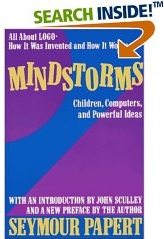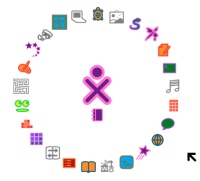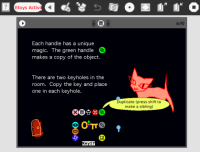The Sugar software for the OLPC XO (and, with Sugar on a Stick, for almost any other recent computer with an x86 processor) is based in part on Seymour Papert's educational classic, Mindstorms: Children, Computers, and Powerful Ideas.
Sharp tools for young minds
One of those Powerful Ideas is to provide Sharp Tools, as opposed to the weak idea of canned lessons on individual topics that go no further. They were originally designed for the factory automation model of education.
You know, everybody in an entire state or country gets the same lesson from the same textbook on the same day. Efficiency! Except when some students don't get a particular lesson, and there is no provision for helping them to catch up.
We still have to offer lessons on the same day for everybody in the same classroom, but we aren't confined to a single textbook, or even the same information on the same topic within a lesson. For example, the lesson may be for a class to go out on the Internet, and for each student to find different information that relates to a topic, and combine the various discoveries. Ivan Krstić mentioned this strategy as one of the first that teachers discovered in Peru.
Another powerful idea is to replace printed textbooks with media and software under Free Licenses such as GPL (GNU Public License) or Creative Commons, as California has begun to do with PDFs of textbooks. But we can go further that that. We can use Sugar tools to create models in math and science. We can use the XO for data acquisition, using Measure and Record, the digital oscilloscope and camera, and we can use the math capabilities of Sugar software to analyze the data. We can help children explore the vast realms of art, music, and literature. But how do we get children to that level?
We have another powerful idea for that: to design software to make it as easy as possible to get started, and to have as few obstacles as possible along the way to using creative tools. This is called Low Floor, No Ceiling. Arithmetic is presented in the schools with a low ceiling, but math in general has no limits. I don't just mean the arcane math that professionals like my brother Gregory work on. (He's a Professor at Rutgers.) I mean math that is easy, interesting, fun, and useful. You may not have heard of such math if you just went through the usual grade school courses, or even college math for non-majors, but I can assure you it exists, and I can point to lots.
For today, I will just make one suggestion. Suppose we taught probability and statistics in terms of baseball batting averages and record performances and the like. How many US children would hate that? It would work for some other countries, such as the Dominican Republic and Japan, where baseball is huge. The rest of the world prefers soccer (football, futbol) or in some cases cricket. It can be curling or chess if that's what floats any children's boats (or rowing, in that case). Can you imagine a generation of children growing up knowing when politicians are abusing statistics?
Starting with Sugar
But, to get back to the beginning, where can children start? All of Sugar is designed to be discoverable where possible. It turns out that there are a few elementary points that cannot readily be discovered, which I have listed on the Sugarlabs Wiki on a page called The Undiscoverable.
Mousing with a touch pad, and left-clicking (X button on the XO), right-clicking, (O button), and click-and-drag are so familiar to seasoned laptop users that they may seem obvious, but to little children they are definitely not. Clicking buttons has to come before menus, launching Activities, and the rest, but after opening the XO and turning it on. Click and drag is essential a little later, for moving and resizing things within Activities, and for making selections in graphics software.
There are also large realms that few children can explore without guidance, such as art, music, math, science, programming, writing...and sharp tools for each that let you explore all of recorded and written music, etc.
So we need to have properly sequenced lessons on the specific beginning points in Sugar, and we have to think about how far we have to guide children before they can effectively explore larger realms on their own. The best existing example of a Low Floor is the set of Tutorial Projects in Etoys displayed on the opening Etoys screen.
One is presented as a game of exploring the Demon Castle, where the learner has to find and change keys to open successive doors. Each of the changes corresponds to a control in the tool halo of an object, such as resizing, rotation, or duplication. This gives the learner a basic grasp of the tools provided.
The second tutorial, Etoys Challenge, is a simple programming challenge. Given an object, in this case a car, get it from the starting point to a designated ending point by controlling the car's path directly, or having it react to obstacles. All of the needed commands are provided on the screen, and the learner just has to determine how to fit them together to specify the desired behavior.
Squeakland has further tutorials on how to modify existing objects and projects and create new ones. We should bring those into Sugar.
The fourth level is provided in a library of projects that students can try out, examine, and modify as they like, as soon as they know how, and in Free books on Smalltalk programming.
Then we only need 10,000 more topics done up with software, media, and lesson plans, in more than 100 languages, to cover every idea in every school subject for every grade. But once the children get started, they will be telling us how to do that, and will in some cases create better lessons than we adults can do from far away, with no idea what problems the children in a particular community need to be educated to solve.
Then we can get the children out on the Net to talk to each other, and to the rest of us. This will be fun. Anybody who wants can have a billion nieces and nephews crowding around to tell stories and show off their work. Is that a powerful idea or what?
Stay current with Sugar Learning Platform - subscribe to OLPC News via RSS Feed, Email or Twitter
.





Demented author writes:
"So we need to have properly sequenced lessons on the specific beginning points in Sugar, and we have to think about how far we have to guide children before they can effectively explore larger realms on their own."
How ironic!
The "revolutionary" software that will let children "learn learning" (nobody seems to have the balls to ask what that actually means - but that's a topic for another day) requires that kids learn its methods in the same old, inefficient way it wants to replace!
The rest of the article, as is always the case with Cherlin's diatribes, is just the inane ramblings of a geek educator-wannabe, not worthy of comment.
Thanks, Irv, as always, for your diatribes. Coming from you, they always count as great praise.
Indeed, Ed, this must be another "Irvin First" winner post.
Winter
My comment is that I think sugar was let down by an under powered processor in the XO. There is a lot to like in sugar. I think I'll try the stick on my 5 year old laptop and see how that works out. If I could upgrade to a new mother board and a better inbuilt mouse the XO would be real nice. I still believe that despite all the knockers there are some real gems in this project!
Nick
I have read the information and also agree with the new technologies to learn the sugar platform software and its various tools.I still believe that despite all the knockers there are some real gems in this project!This software give learning advantages to young and small ones.So we need to have properly sequenced lessons on the specific beginning points in Sugar.
Ed,
I really appreciate this post.
I am a middle school science teacher and doctoral student. We have 6 5th grade classrooms, 5 of which use XOs and the 6th uses netbooks with Sugar on a Stick.
This deployment is the foundation of my doctoral research.
I definitely agree with your notion of the Undiscoverable. But I am have also seen that it doesn't take much for them to get, say, the basics of the Sugar UI.
The other major trend at this point is that after a short while, they by and large have no interest in just being consumers with the XOs/Sugar. The really explosions in learning happen when they become consumers. Right now, 3 of the classrooms are engaged in EToys projects, and the students are developing books helping them to understand some concepts in ecology.
Thanks again.
Gerald